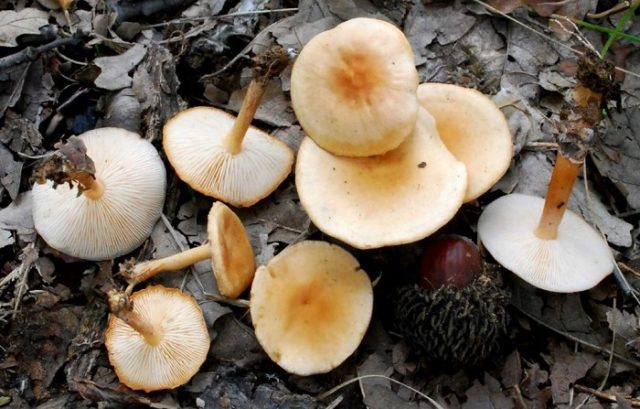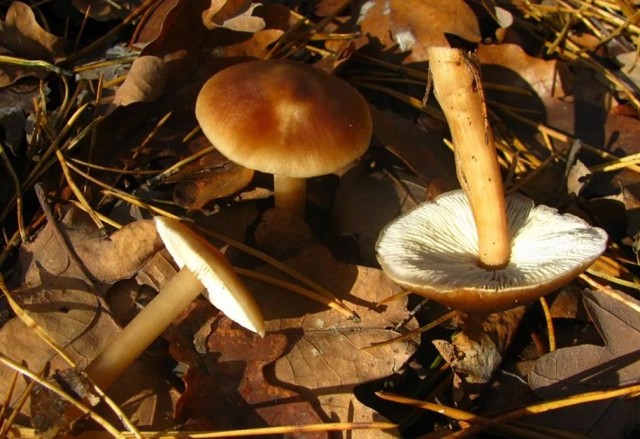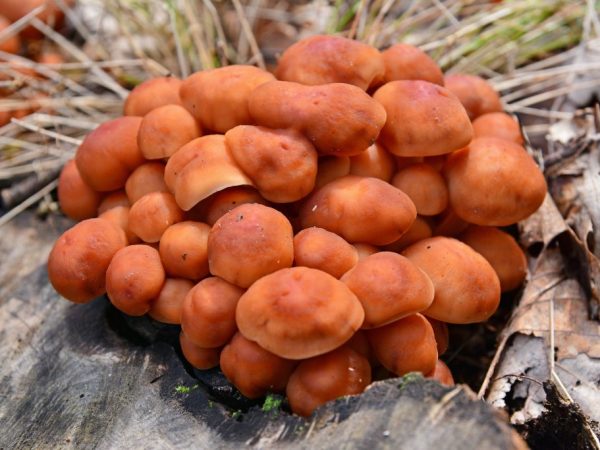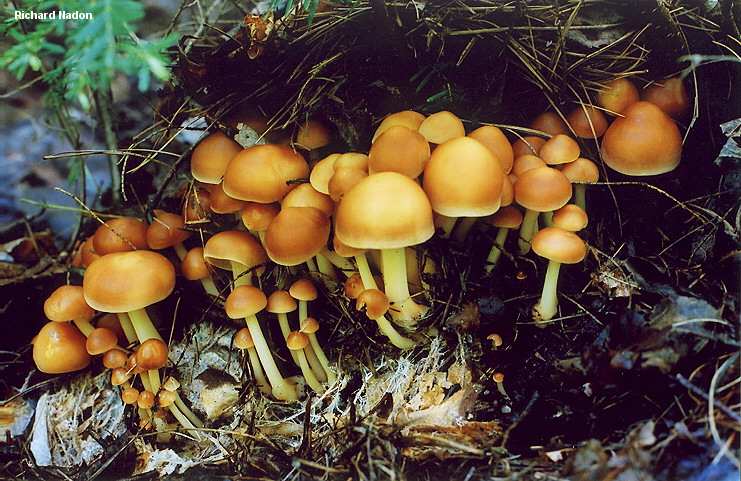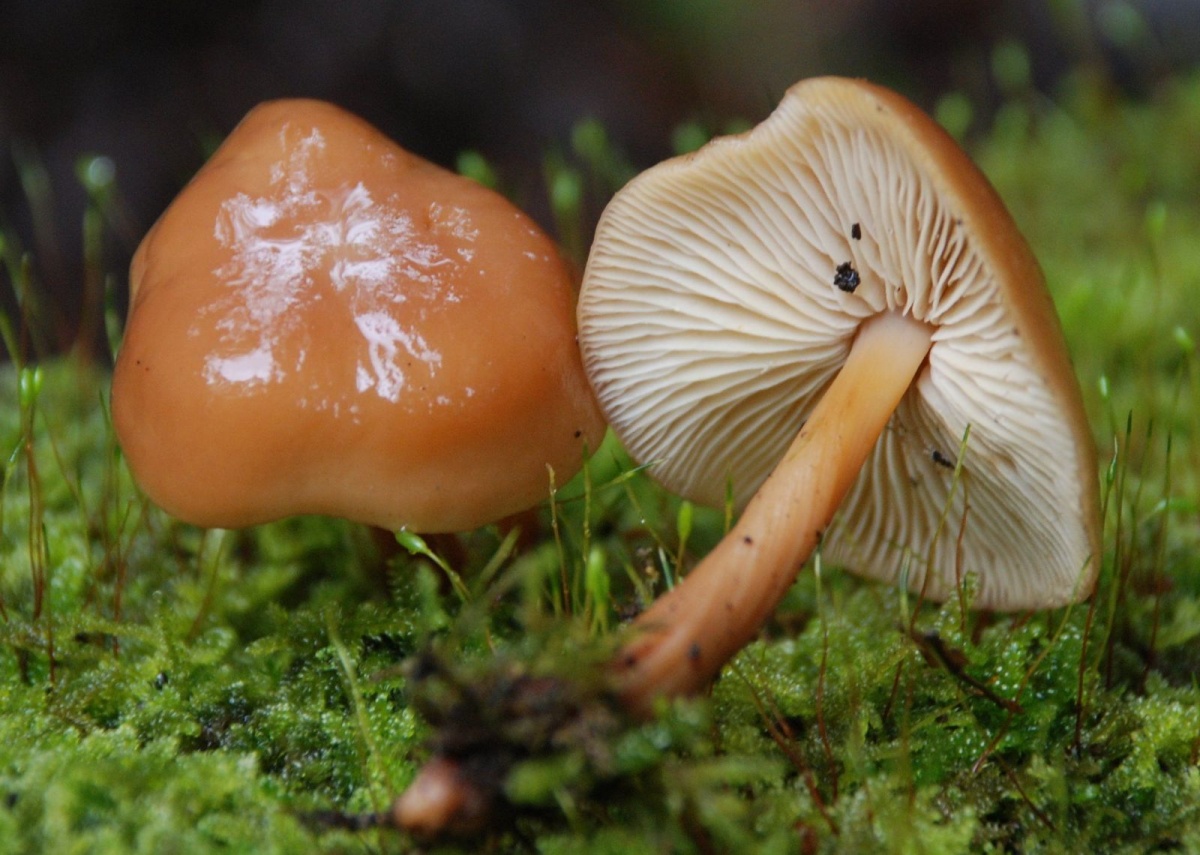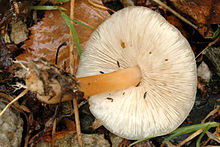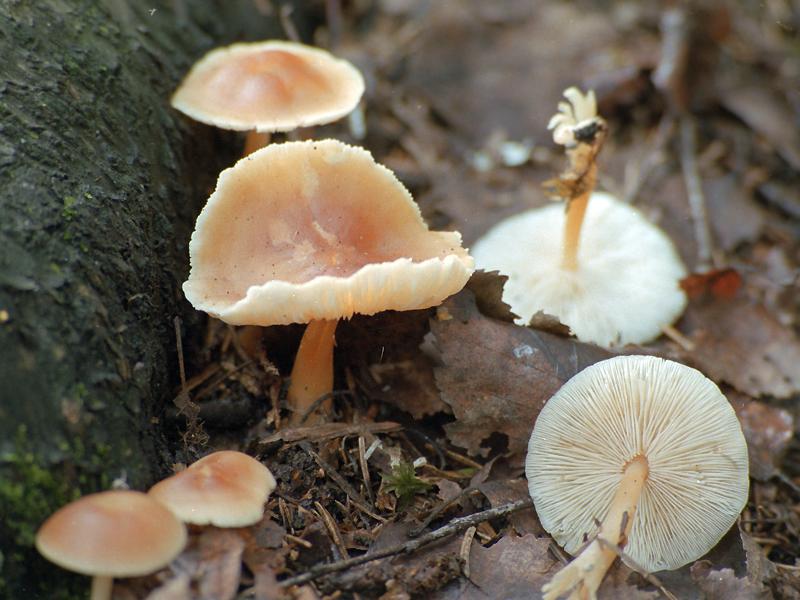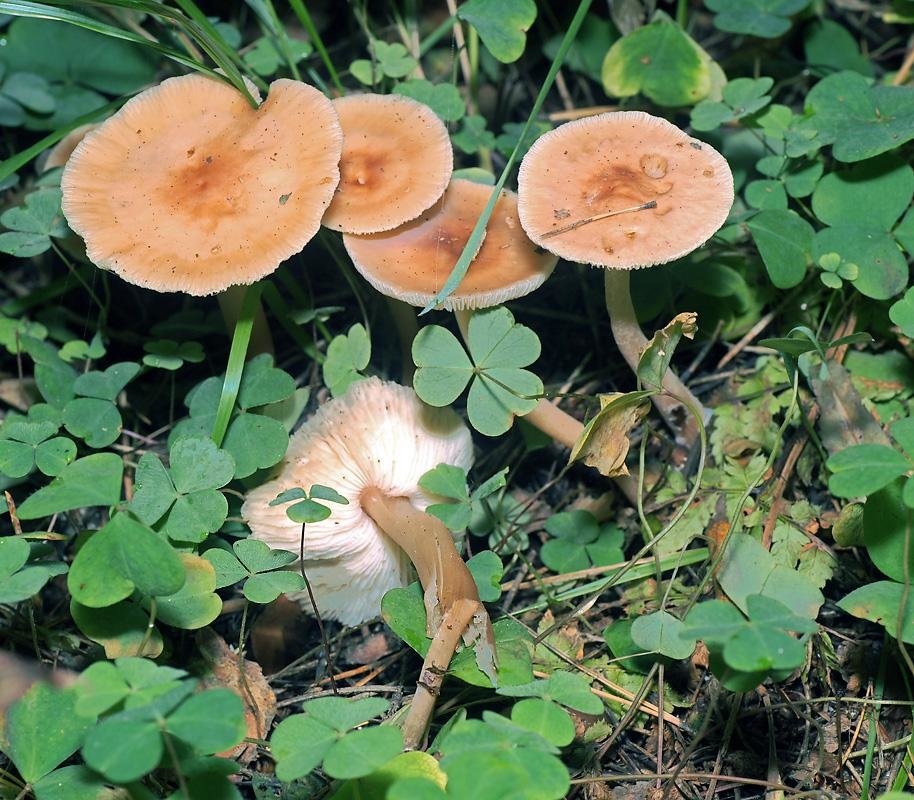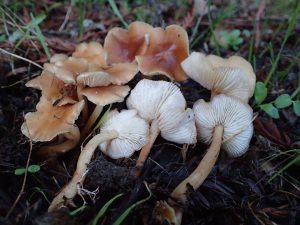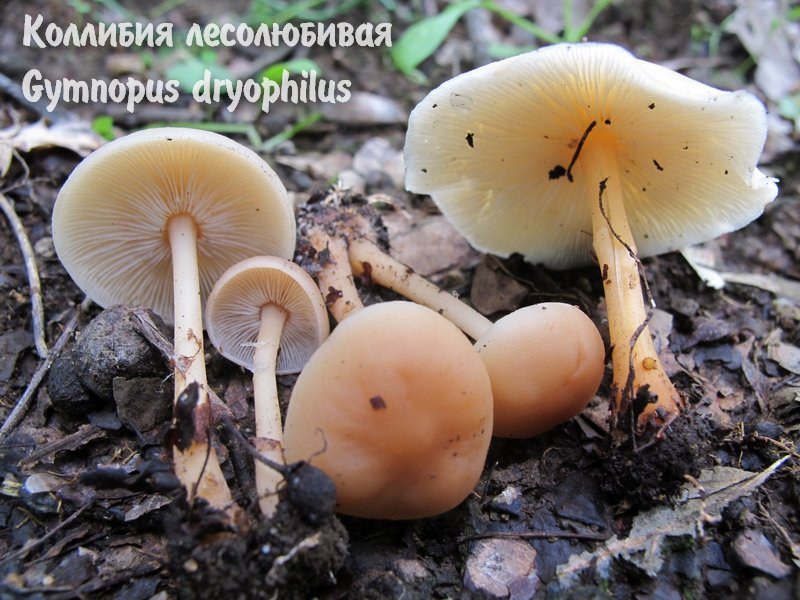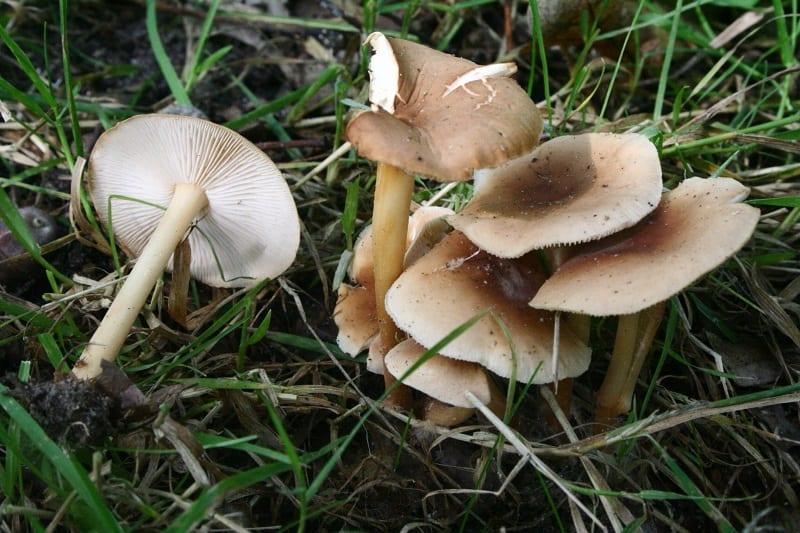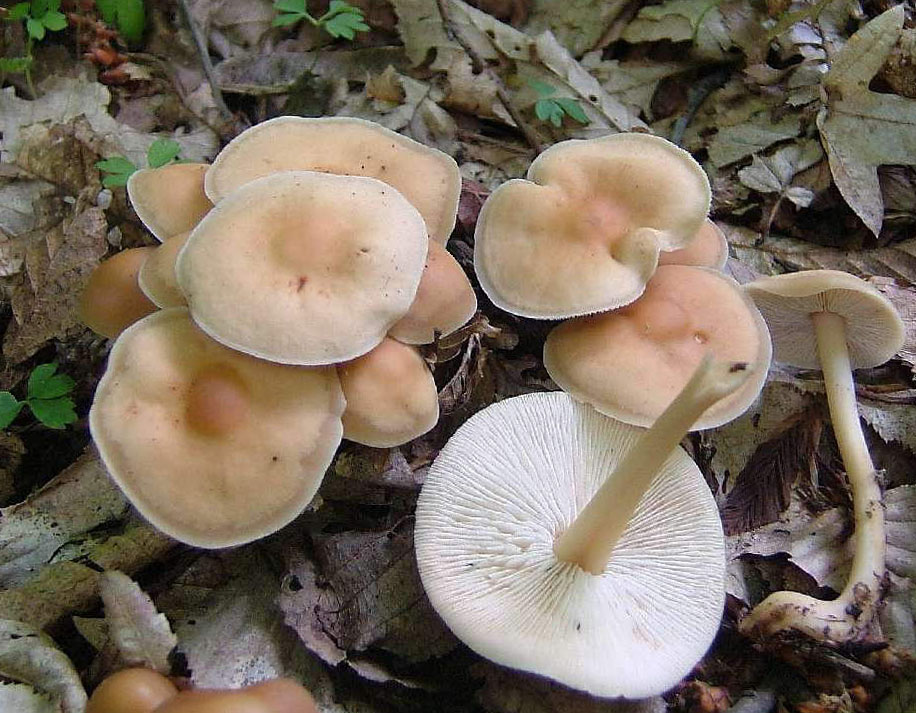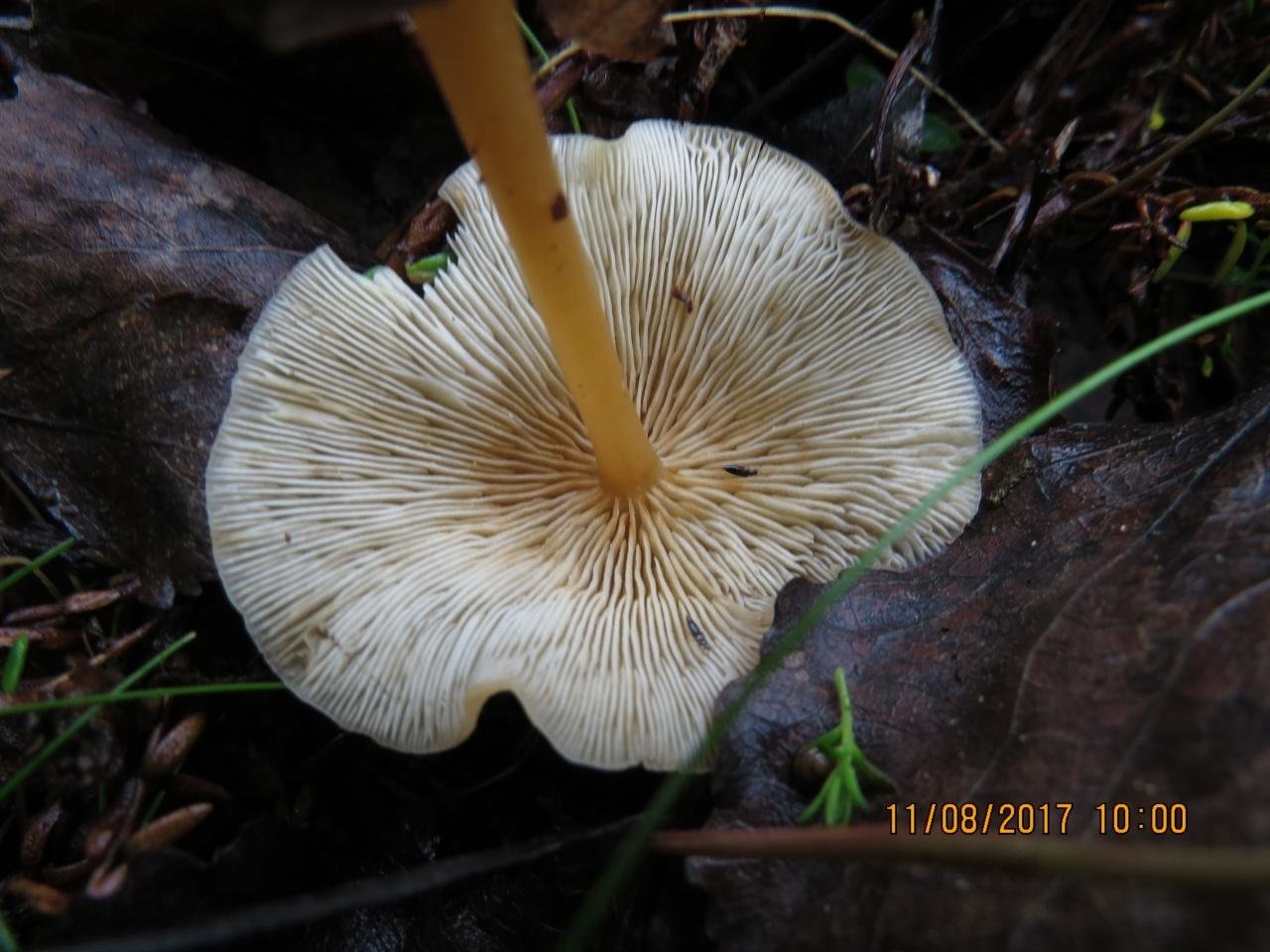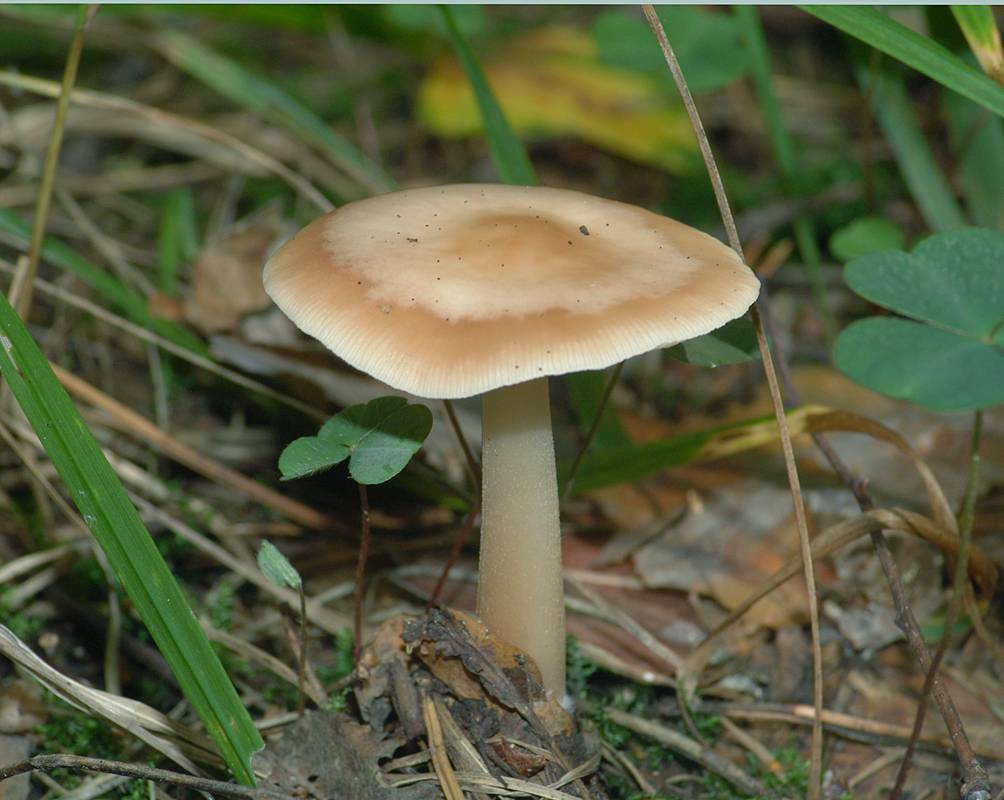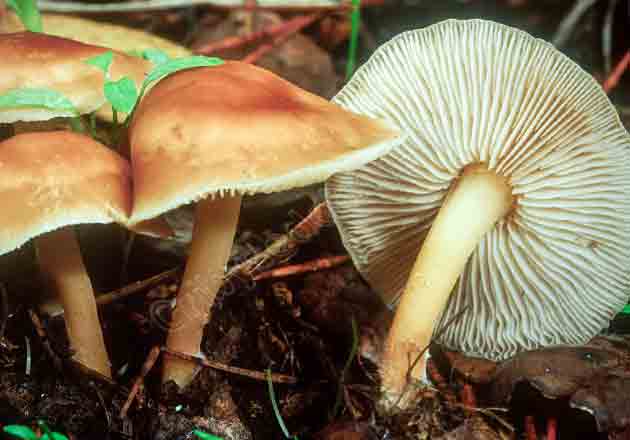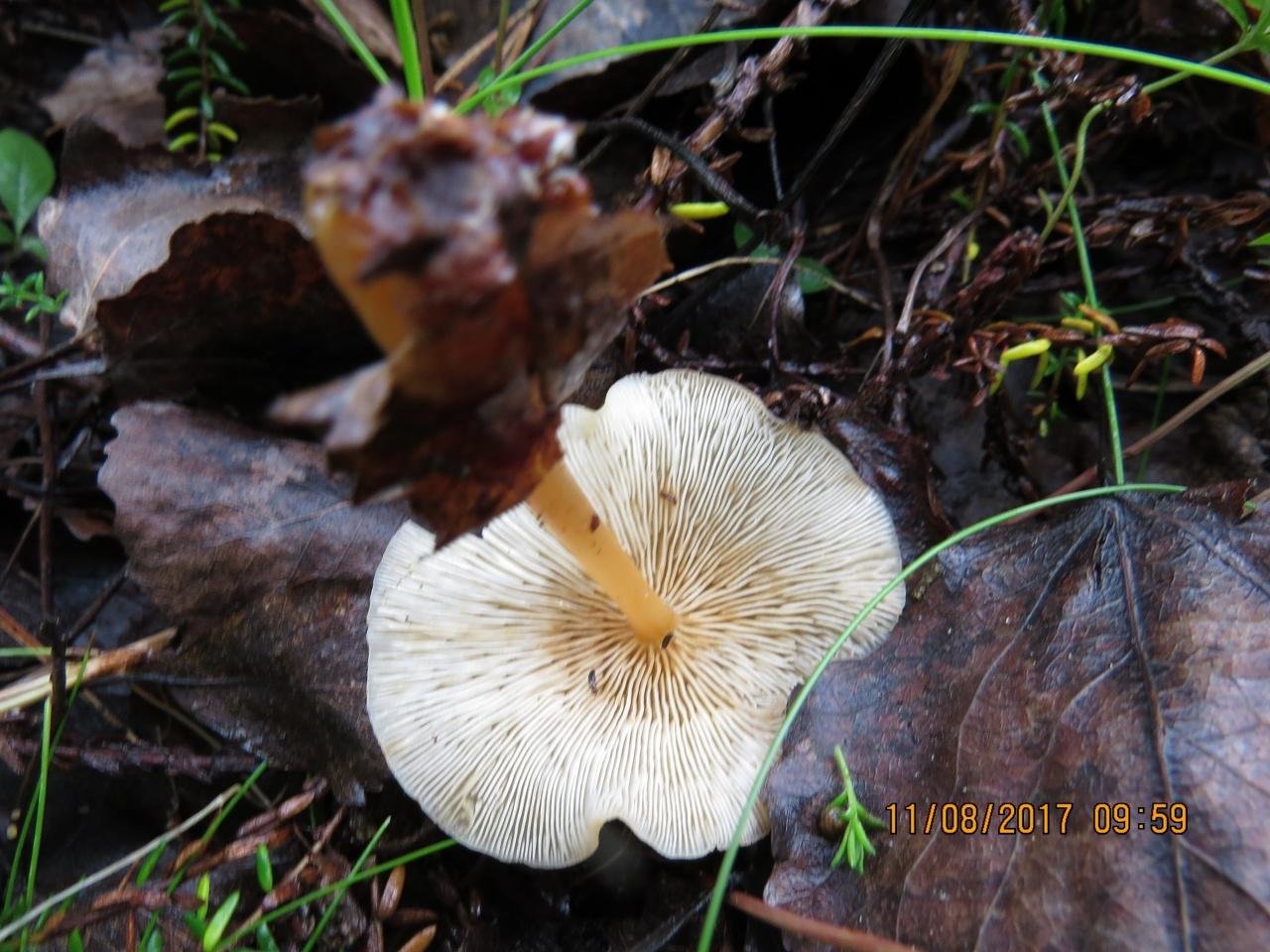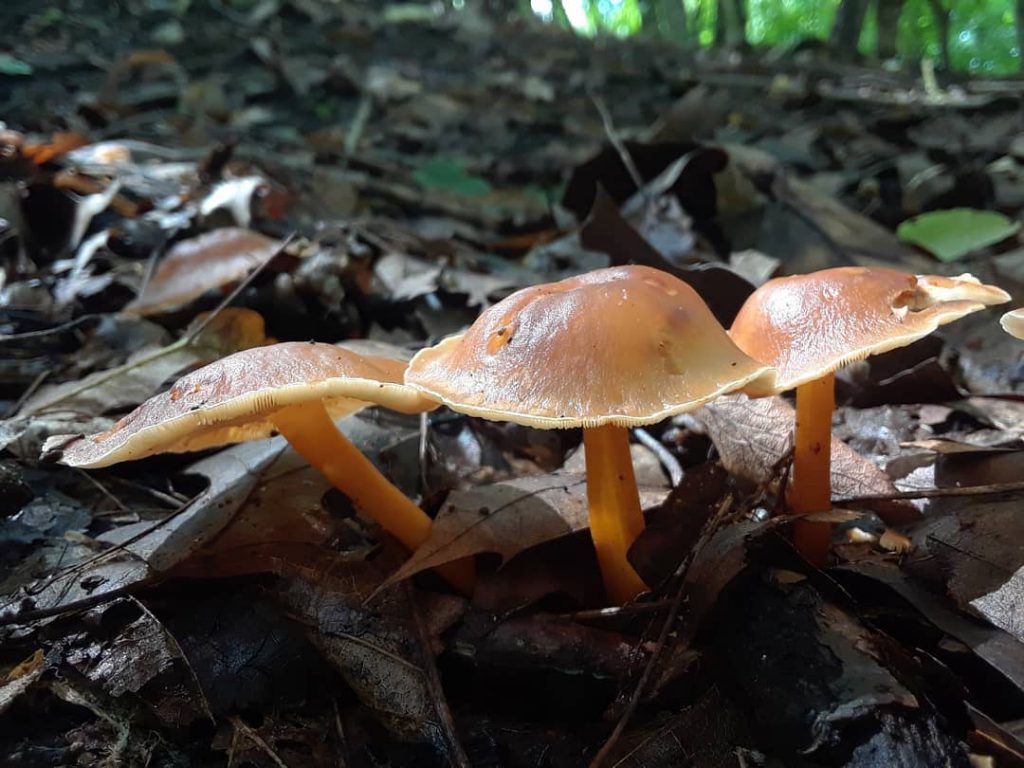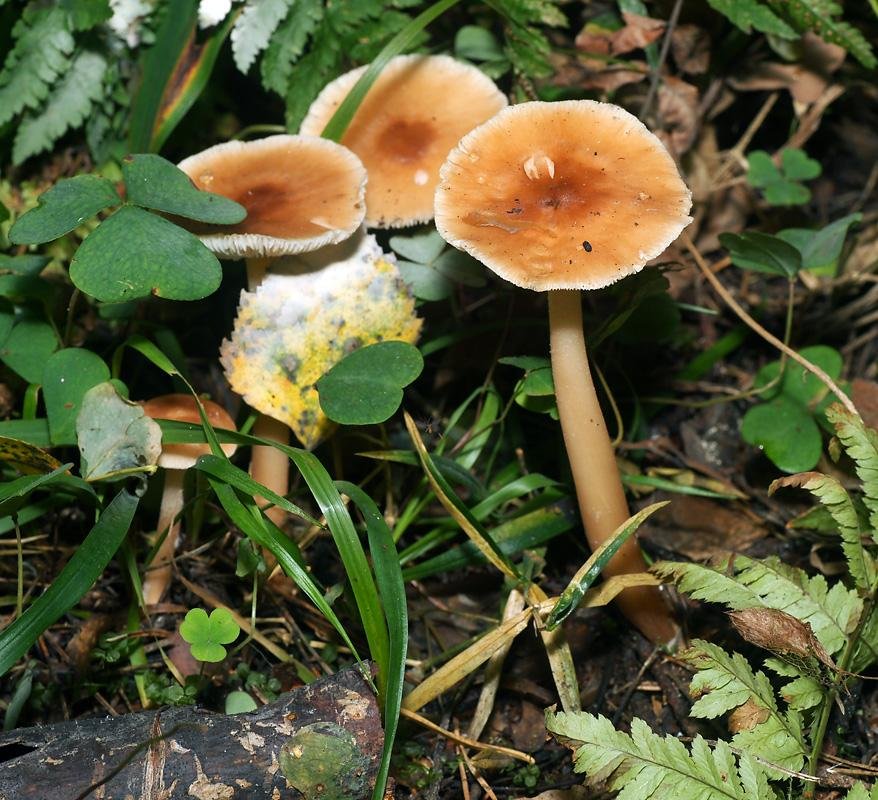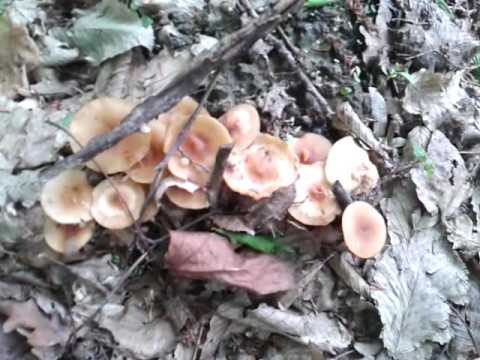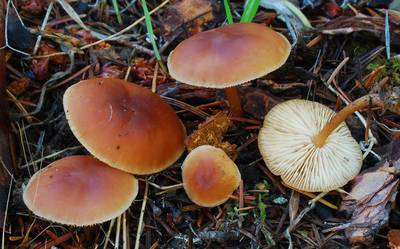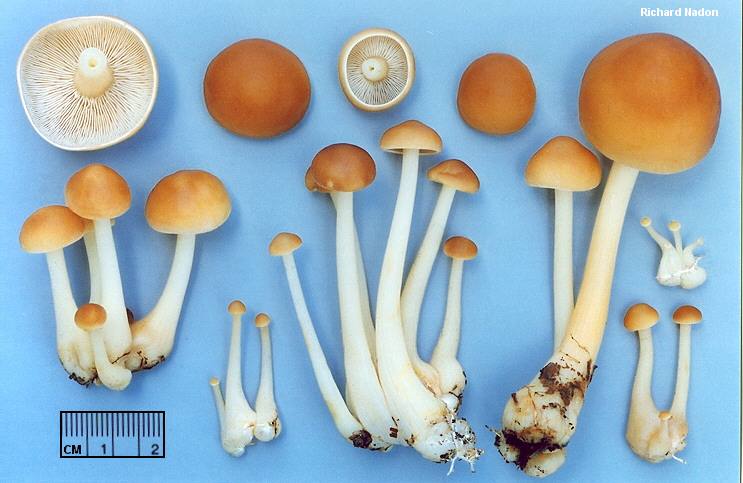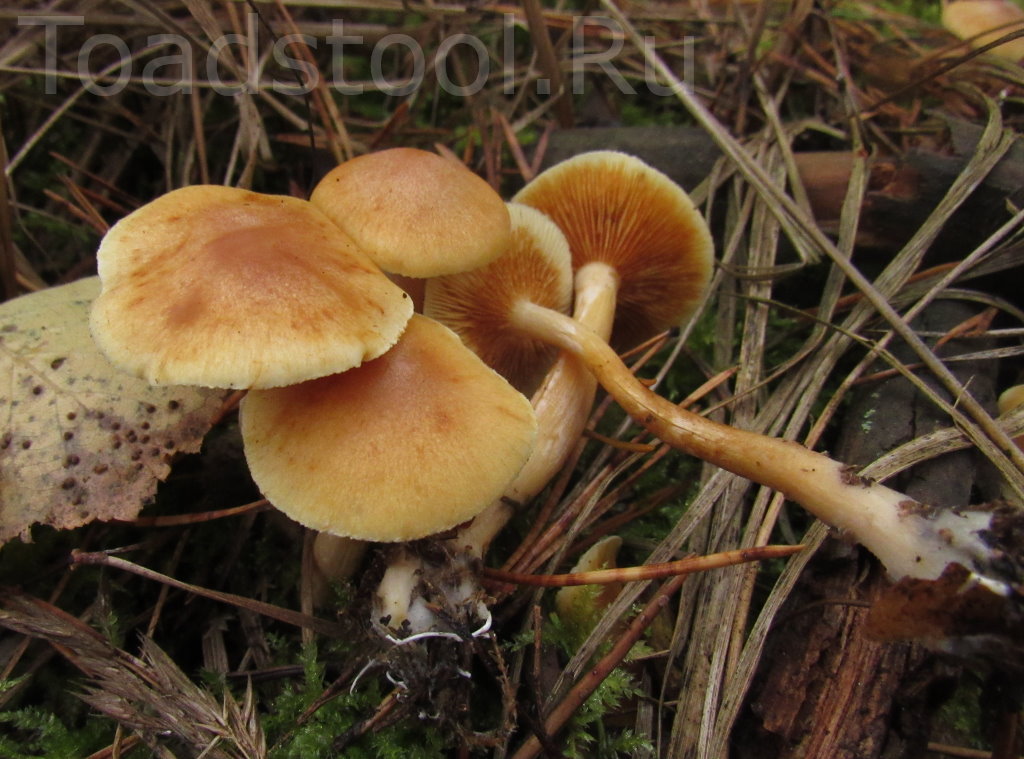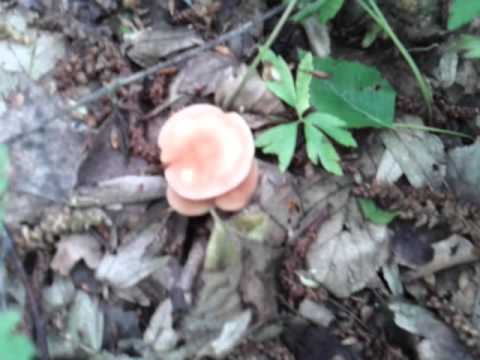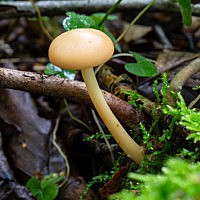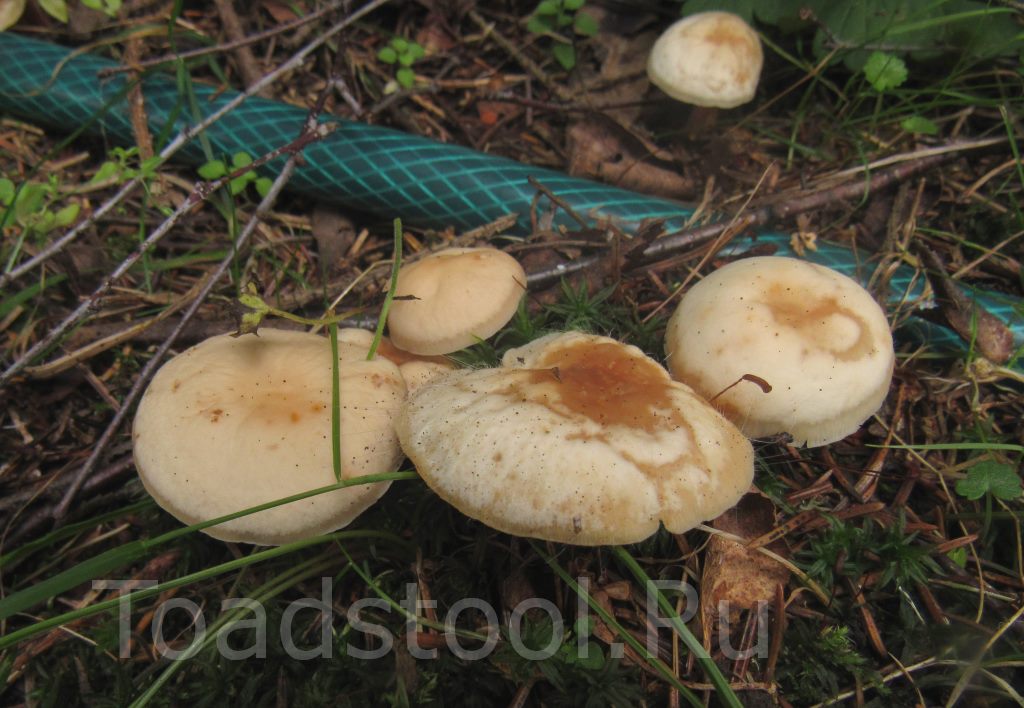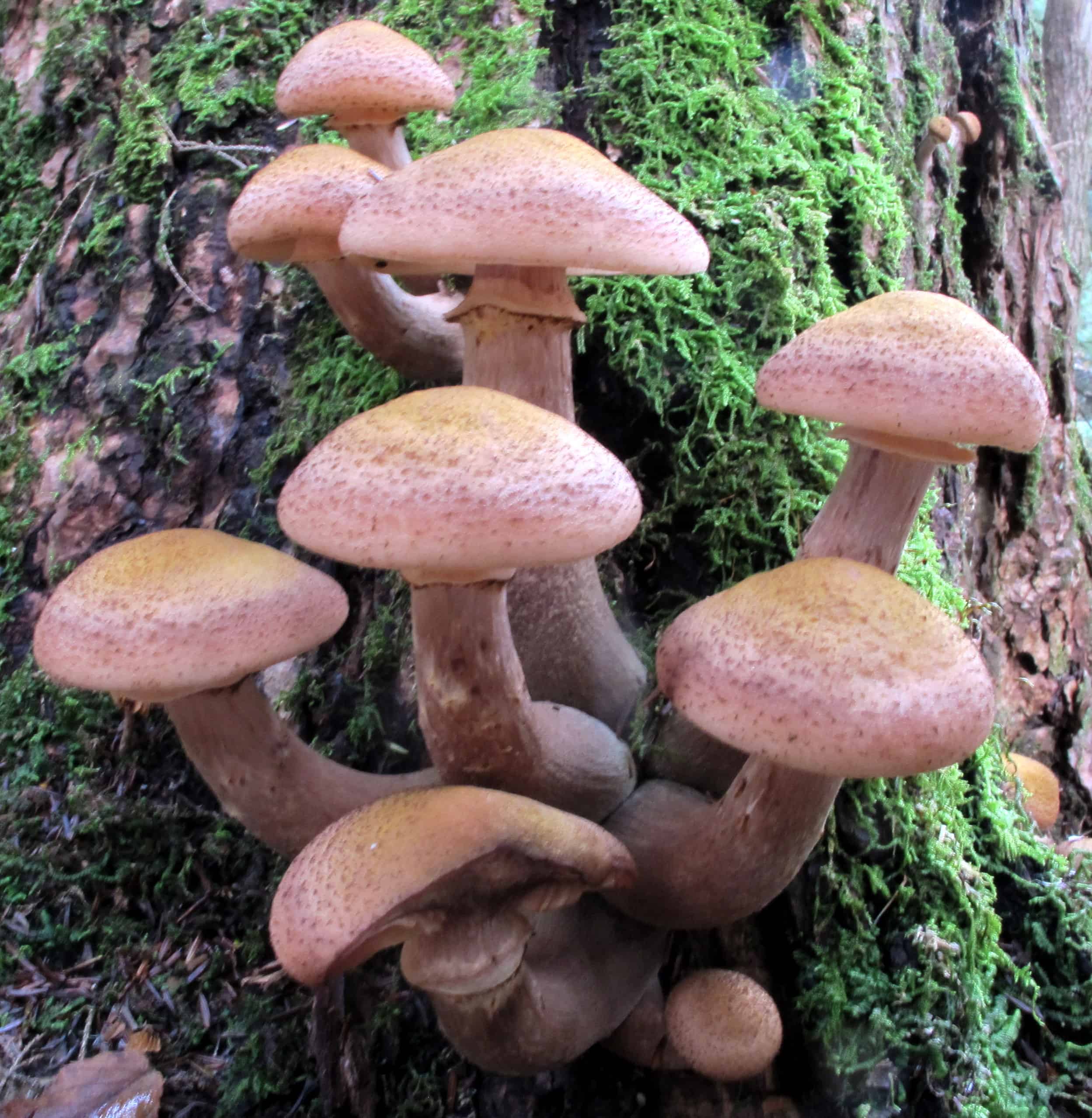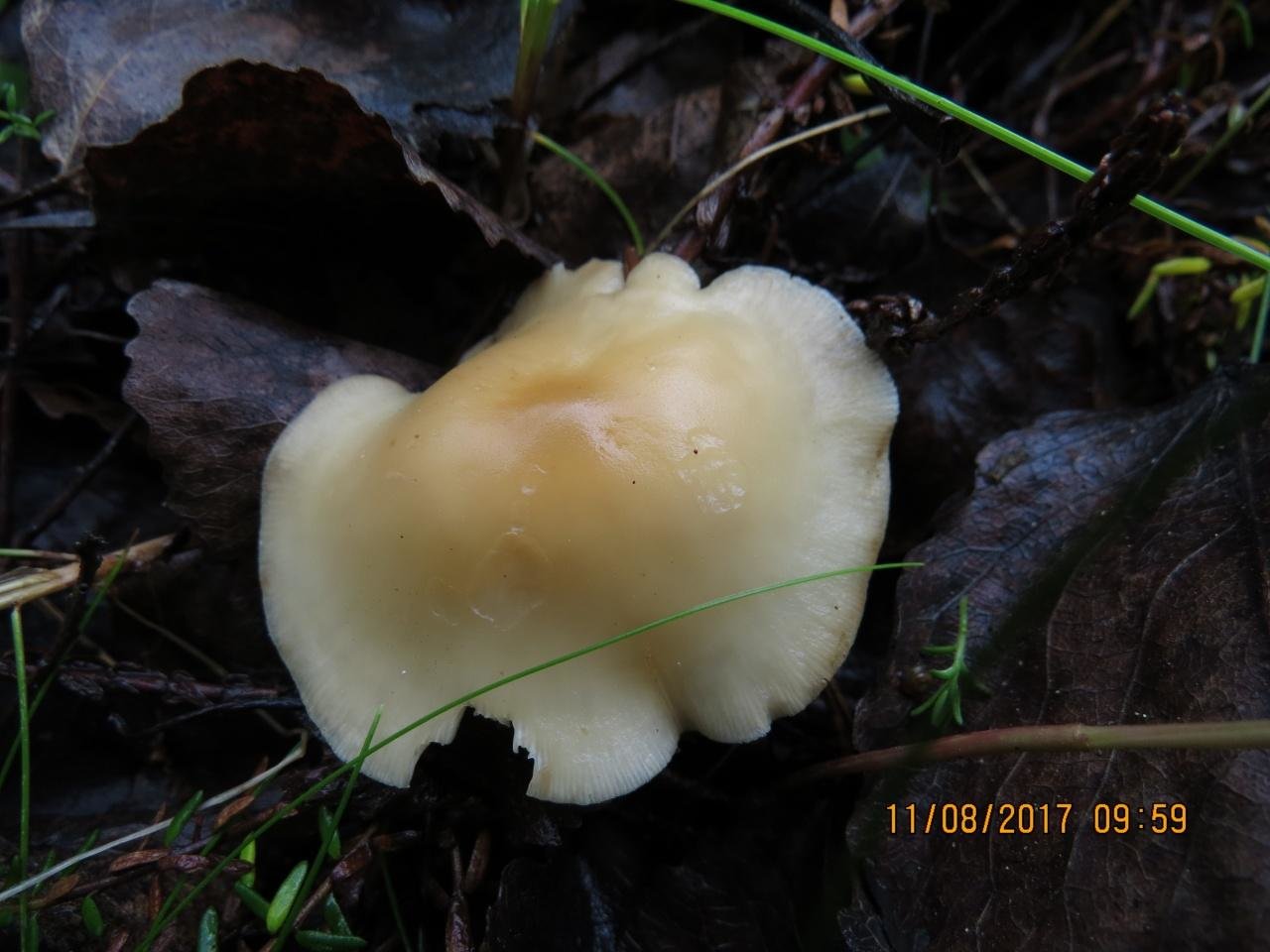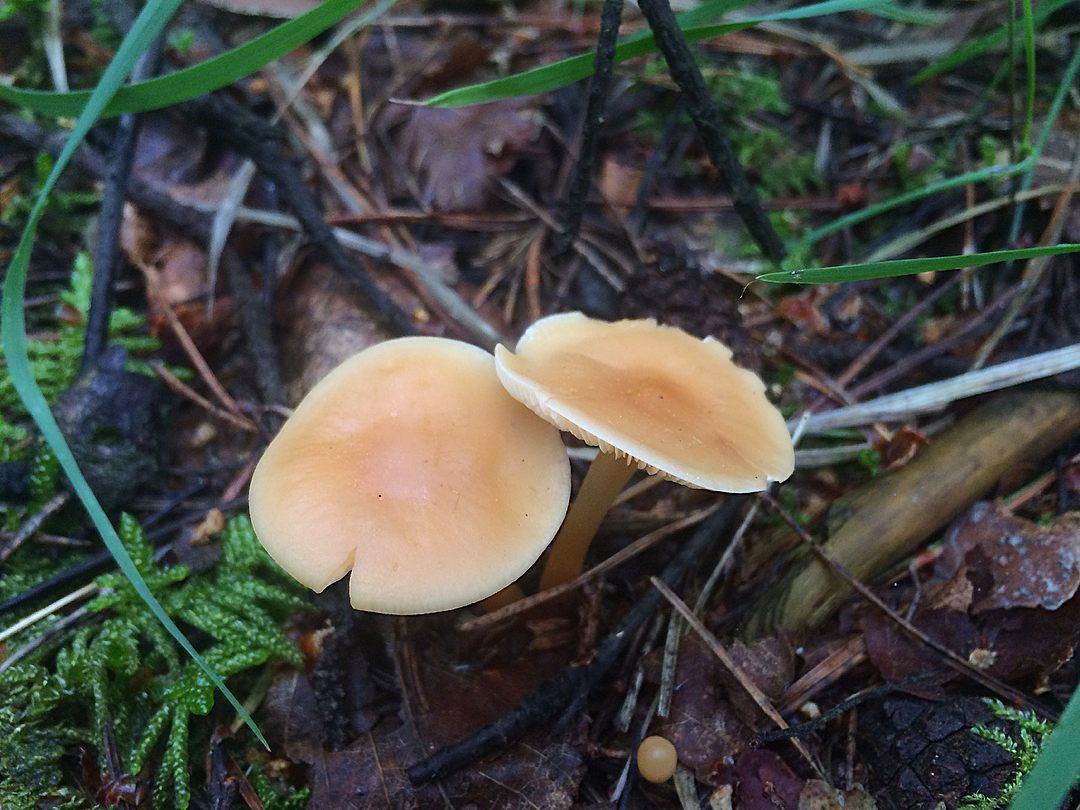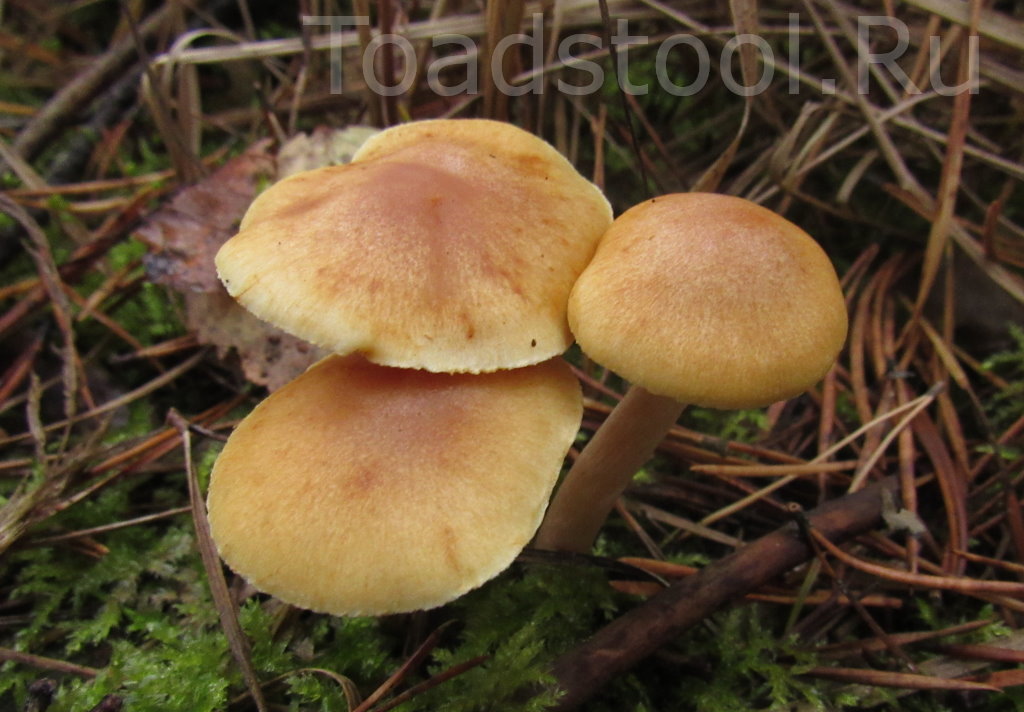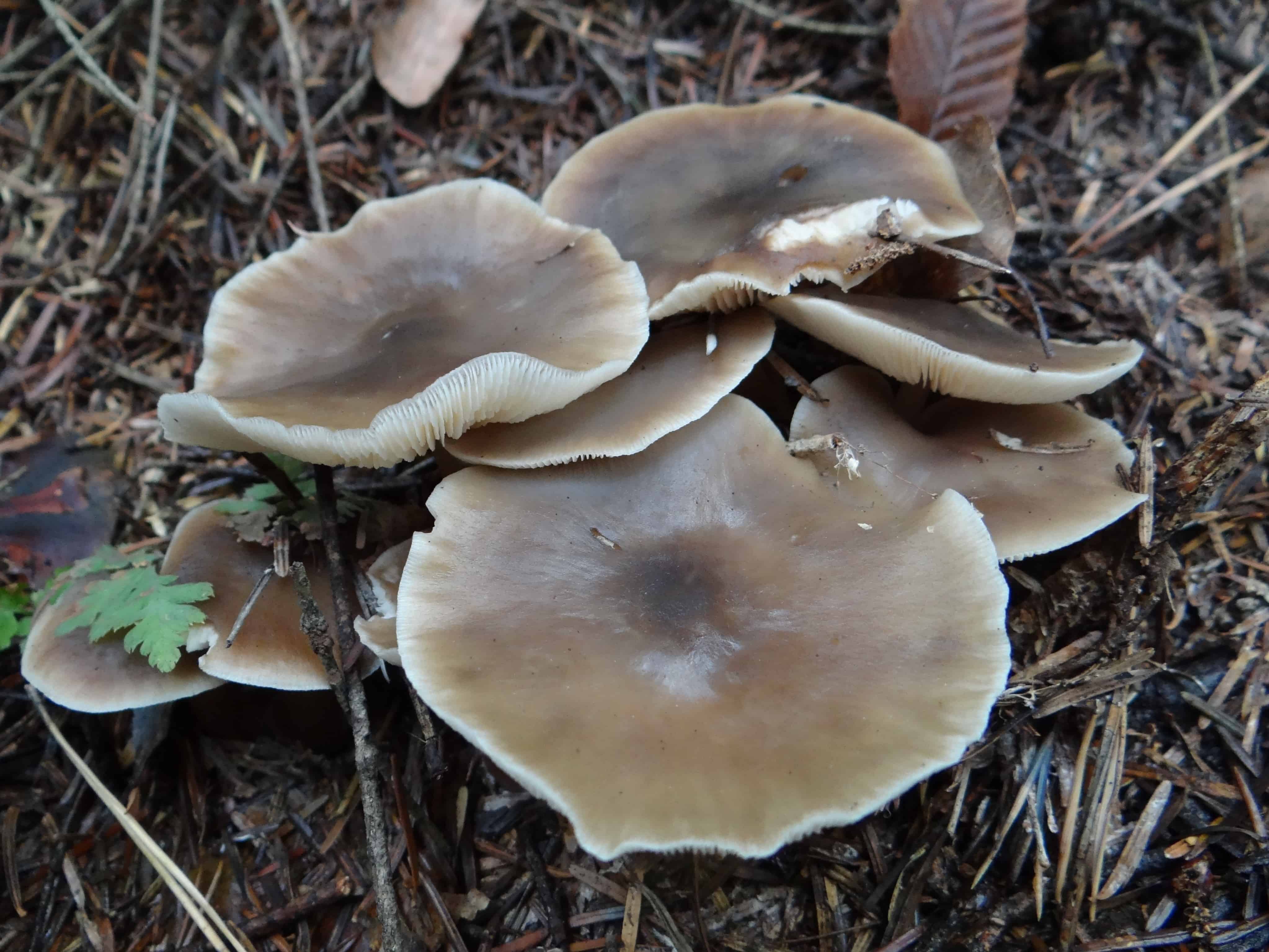Description
Hat
Small, rarely grows more than 6 cm. The flesh is rather thin and fragile, often translucent, hygrophane. The skin of the cap is smooth, slightly sticky in wet weather. The color spectrum of the cap is very wide, from light, pale cream to ocher and brown. In youth, the cap has the shape of a hemisphere, then it becomes hemispherical, later spread out, with a wavy edge. Sometimes the edges of the cap are bent upwards.
Spore-bearing layer
Lamellar. The color of the hymenophore is white, cream or yellowish. The plates are often located, mostly free, only some grow to the stem. There are many shortened plates that do not reach the leg. Spore powder is cream, spores are drop-shaped.
Leg
Up to 5 cm in height, occasionally up to 8 cm. Regular cylindrical shape, elastic structure, solid. At the base of the peduncle there is a characteristic thickening, covered with a white bloom of mycelium. The color of the leg matches the color of the cap, sometimes a little darker.
Gymnopus yellow-lamellar (colibia yellow-lamellar): photo and description
| Name: | Gymnopus yellow-lamellar |
| Latin name: | Gymnopus ocior |
| Type of: | Edible |
| Synonyms: | Collybia yellow-lamellar, Hymnopus early ripening, Collybia ocior, Collybia funicularis, Collybia succinea, Collybia extuberans, Collybia xanthopus, Collybia xanthopoda, Collybia luteifolia, Collybia aquosa var ocior, Collybia dryophila var xanthopophila, vararami dryus extinct Marasmius dryophilus var funicularis, Chamaeceras funicularis, Rhodocollybia extuberans |
| Specifications: |
|
| Systematics: |
|
Colibia yellow-lamellar is an edible variety of the mushroom kingdom. But very often mushroom pickers ignore this species, implying a poisonous variety by it. During mushroom hunting, in order not to accidentally collect false doubles, it is necessary to study the characteristic features of the variety and view the photo.
Watery hymnopus (Gymnopus aquosus)
Current title
| Index Fungorum | Gymnopus aquosus (Bull.) Antonín & Noordel. | |
| MycoBank | Gymnopus aquosus (Bulliard) Antonín & Noordeloos |
Systematic position
Etymology of the species epithet
Aquosus, a, um, 1) abundant in water, 2) water-loving + osus, a, um (enhanced value).
Synonyms
- Agaricus aquosus Bull., Herb. Fr. (Paris) 1: tab. 17 (1781)
- Collybia aquosa (Bull.) P. Kumm., Führ. Pilzk. (Zerbst): 114 (1871)
- Collybia dryophila var. aquosa (Bull.) Quél., Enchir. fung. (Paris): 31 (1886)
- Collybia dryophila var. oedipus Quél., Fl. mycol. France (Paris): 226 (1888)
- Marasmius dryophilus var. oedipus (Quél.) Rea, Brit. basidiomyc. (Cambridge): 525 (1922)
Other names: Colibia water-loving.
Habit
Fruit body: Cap and stem (agaricoid)
Hymenophore: Lamellar (including folded or with rudimentary plates)
Hat
The cap is 25 - 65 mm in diameter, at first it is hemispherical with a lowered edge, then it opens up to extended with a slightly depressed center; the edge sometimes becomes wavy. The color is relatively faded, from whitish to ocher, smooth, slightly sticky in wet weather.
The plates are loose, frequent, white or creamy.
Leg
Stem 15 - 70 mm long, 2 - 3.5 mm in diameter, usually slightly widened towards the base, whitish in the upper part, slightly darker downward, smooth, with pinkish pubescence at the base.
Pulp
The pulp is the same color with the cap; the smell is pleasant, mushroom.
Microscopy
Spore powder is white.
Spores (5.0) 5.5 - 7.5 (8.0) × 2.7 - 3.5 (4.0) μm, Q = 1.9, wide-ellipsoidal or teardrop-shaped.
Basidia 17 - 24 × 4.5 - 8.5 μm, clavate, 4-spore, with a buckle at the base.
Basidiols 8.0 - 27 × 2.5 - 7.0 μm, clavate, fusiform.
Cheilocystids 15 - 47 × 5.0 - 15 µm, clavate or spherical, sometimes bifurcated, transparent.
Pleurocystids are absent.
Buckles are found in all fabrics.
Ecology and distribution
Substrate: Soil, litter
It usually grows in groups on the soil, among grass and mosses, in coniferous and deciduous forests.
Fruiting
The divisions correspond to the decades of the month.
Nutritional properties
Similar species
Spring mushrooms in a broad sense (subsection Levipedes of the genus Gymnopus) are quite recognizable due to their characteristic habit, cartilaginous, slightly translucent flesh and smooth stem with pubescence only at the base. However, it can be extremely difficult to distinguish between them. The point here is in the large intraspecific variability caused by weather and ecological conditions (due to strong hygrophilousness, for example, the same fruit body can be almost white in dry weather and brown in wet weather), as well as the similarity of the main microscopic features. But an attentive observer will eventually be able to distinguish between the main species found in local forests.
- Blood-legged honey fungus (Gymnopus erythropus) is well distinguished due to pronounced red tones in the coloration of the peduncle and basal pubescence; usually grows more crowded.
- Spring honeydew (Gymnopus dryophilus) is distinguished by a more saturated color of the cap and a lighter leg; ecologically plastic species: as a rule, on litter in deciduous forests, often in parks, but also found in coniferous stands, often in sphagnum.
- Gimnopus early maturing (Gymnopus ocior) is usually darker colored, with more or less pronounced yellow tones in the color of the plates.
Related materials
- Antonin V., Noordeloos N. E. A monograph of marasmioid and collybioid fungi in Europe. - Eching: IHW-VERLAG, 2010 .-- 480 p. - P. 183.
- Antonín V., Sedlák P., Tomšovský M. Taxonomy and phylogeny of European Gymnopus subsection Levipedes (Basidiomycota, Omphalotaceae). // Persoonia. - 2013. - V. 31. - P. 179-187. DOI: 10.3767 / 003158513X674043.
Link to this page for prints
Description of the Collibia mushroom and its varieties
The colibium fungus belongs to the Tricholomaceae family. It has several varieties, among which the most famous are the forest-loving, broad-lamellar, oily and fusiform.
Description of the Collibia mushroom and its varieties
general characteristics
All members of the Collibia genus have similar characteristics:
- The mushroom cap is thin-fleshy, in rare cases has developed flesh, small in size, does not exceed 2 cm in diameter, convex in shape at the initial stage of growth, subsequently flat-spread, in adult specimens a fossa appears in the central part, in young mushrooms it has tucked edges, color pale in shades of white, brown and yellow,
- the mushroom hymenophore is formed by frequent plates adhered to the bases of the mushroom stem or free, the color of the hymenophore plates is pale cream or light brown,
- the mushroom leg is thin in shape, covered with a mealy bloom, the lower part of the leg is hairy, the shape of the leg is often even, in some cases swollen.
Some types of colibia form sclerotia.
Geography of distribution
The genus collibius is widespread in temperate latitudes in the European and North American territories. In total, there are about 70 varieties, in Russia there are about 20 species.
Spindle-footed
Collibia fusiform grows on the stumps and roots of old deciduous trees, preferring oak and beech. A hat with a diameter of 4.0-8.0 cm, with a blunt tubercle. The spindle-shaped leg is 4-8cm long, 0.5-1.5cm thick. The color scheme is in red-brown shades.
Widely distributed in European forests. The fruiting period is in summer and autumn. It is considered inedible, but there are cases of the use of young specimens with exquisite gastronomic qualities. Overgrown specimens cause mild poisoning.
Oil
Colibia oil prefers coniferous forests, grows in colonies. The fruiting period is July-November.
A hat with a diameter of 2-12 cm, the surface is smooth, when moisture gets into it, it becomes oily. The color is brown or with shades of red. Mushroom leg 2-10 cm long, 0.4-1.0 cm thick, often hollow, hard, smooth surface. It belongs to the edible species.
Lazy
The fungus grows in colonies
Wood-loving colliery grows in small colonies in mixed woodlands along with oak and pine, preferring decaying wood and fallen leaves. The fruiting period is June-November.
A hat with a diameter of 1-7 cm, the color is initially red-brown, later with an orange tint or yellow-brown. The mushroom leg is 3-9cm long and 0.2-0.8cm thick. Collibia les-loving belongs to the edible species.
Bored
The crowded variety grows near grassy paths, in clearings in coniferous forests, in hilly areas.
The hat is 1-4cm in diameter. the surface is shiny. The leg is in the form of a cylinder, 5-10cm high, up to 3mm thick. the fruiting period is in spring-autumn.
The mushroom is an edible species.
Wide-lamellar
Colibia broadly lamellar is one of the early lamellar fungi. Grows singly or in small colonies. It is a saprotroph, preferring the rotten stumps of broad-leaved trees.
A hat with a diameter of 5-12 cm, radially cracking in dry weather. The surface is gray or brown. Mushroom leg 4-15cm, dense in structure.
It belongs to the edible species.
Water-loving
Collibia water-loving grows in forests in wetlands with stagnant water, near the passage of groundwater, prefers moss, grass and soil rich in woody debris. The fruiting period is mid-May-November.
Mushroom cap with a diameter of up to 6 cm, initially with smooth, later with wavy edges. The surface is smooth. The color is usually cream, light brown. Leg up to 8cm long, 0.2-0.4cm thick, cylinder shape.
It belongs to the edible variety.
Conclusion
Colibia belongs to the genus of basidial lamellar fungi from the family of rowers. It has several varieties, most of which are edible or conditionally edible.
Is the les-loving Collebia edible or not
Wood-loving colibia is conditionally edible, only the tops are eaten, but they are rarely used in cooking, since a large amount of product will be needed for harvesting, and the taste of spring honey will not please everyone. If the wood-loving colibia is improperly processed, a person who does not suffer from a digestive system disorder may experience pain in the stomach or intestines.
The aroma of a mushroom dish is also repulsive, for many it resembles the smell of mold or rot. However, adherents of healthy lifestyles collect and eat wood-loving colibia, since scientists have proven that it contains a large number of active elements that are beneficial to health. They increase the body's immunity and resistance to infections, promote heart function and strengthen blood vessels, are a natural antioxidant, immunostimulant and antiviral agent. The wood-loving colibia contains a lot of proteins, carbohydrates and fiber, as well as vitamins (B1 and C), zinc, copper and minerals.
Collibia les-loving - description, where it grows, the poisonousness of the mushroom
According to the variety of mushrooms, the wood-loving colibia is classified as a non-nylon mushroom family. The people call this variety of mushrooms the spring mushroom for its external resemblance to mushrooms. However, such confusion often occurs due to the mistake and inexperience of the mushroom pickers themselves. In fact, colibia is considered a parasitic fungus and has nothing to do with mushrooms.
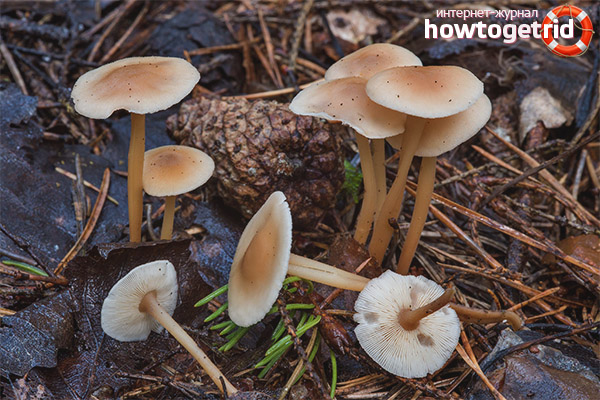
According to the classification of edibility, the representative of the mushroom kingdom, the colibia, is usually classified as conditionally edible mushrooms of the fourth category. After the collibia is in the mushroom picker basket, it should be cooked. The mushroom must first be boiled and the resulting broth drained, only after that it can be used for food.
Characteristics of the forest-loving colibia
Young colibia mushrooms have a cap that looks like a sphere. As the mushroom develops, its cap takes on a spread, flat shape with transparent margins. The diameter of the mushroom cap reaches about 2-6 cm. Young colibia fungi have some similarity with apples that fell on fallen leaves in the forest.
The core of the mushroom has brown, light yellow or sometimes white flesh. The color of the pulp directly depends on the conditions and environment in which the mushroom matures. If you look through the thin and transparent edges of the cap, you can see the plates that are weakly attached to the base of the mushroom.The older the mushroom ripens, the more it will become covered with reddish spots that appear on the inside of the fruit. The transparent and thin edges start to tear.
The mushroom leg has a thin base, it is hollow inside and twists slightly along its length, at the end it thickens a little. The structure of the stem of the fungus has a fibrous and cartilaginous surface. The cap and leg are the same color. The mushroom leg can be up to 2 or 6 cm in length.
Is the les-loving kollibia edible?
Colibia is an edible mushroom, so it can be used in recipes. However, due to its low taste, it is not in great demand among mushroom pickers. In addition, if a person has disorders associated with digestive problems, then you should not use this mushroom for food. Colibia can cause intestinal and stomach ailments and painful sensations.
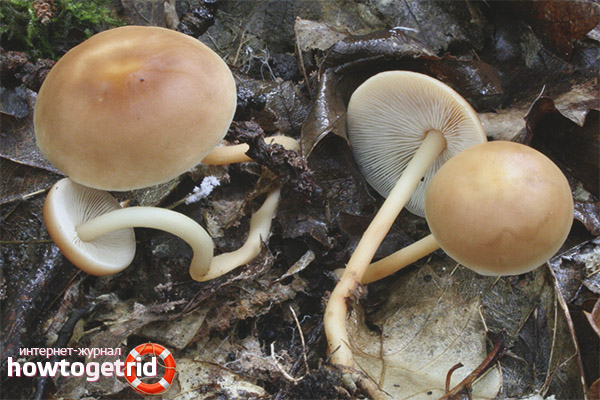
Colibia is also not very popular among chefs, as the inside of the mushroom has very little soft core and pulp for cooking. In addition, the mushroom does not have a strong aroma and taste. The aroma of colibia can even, on the contrary, give dishes an unpleasant smell with an admixture of mold and rot.
Growing environment of colibia
The habitat of the fungus is considered to be the forest, which is why the colibia is called wood-loving. You will not find it in fields or gardens. Colibia can be found in the deciduous and coniferous thickets of the forest. This type of mushroom family grows most often in the European part of Russia.
The first mushrooms germinate in May and give inputs until the end of autumn. You can find colibia among foliage, in a damp lowland, in a rotting fallen tree or on a stump, thanks to which the fungus survives and receives the substances and water it needs. Also, the fungus can grow on the surface of the tree trunk.
Doubles in the kingdom of mushrooms
There are wood-loving kollibia and close relatives. Colibia is considered such a relative of the fungus, it also belongs to the conditionally edible varieties of mushrooms. The mushroom is brown or red-brown in color. Also, wood-loving kollibia can often be confused with some other species of the kolibia family, which, moreover, can be very poisonous and life-threatening. However, poisonous varieties are rare. Only experienced mushroom pickers can find the difference between a poisonous and an edible mushroom.
Crowded colliery (Gymnopus acervatus) what mushrooms look like, where and how they grow, are they edible or not
Collibia crowded: photo and description
| Name: | Collibia crowded |
| Latin name: | Gymnopus acervatus |
| View: | Conditionally edible |
The crowded colliery is a conditionally edible forest dweller. It grows on stumps and decayed coniferous wood. Caps of young mushrooms are used for food, since the flesh of old specimens is tough and fibrous
Because this species has inedible counterparts, it is important to get acquainted with the external description, analyze its photos and videos
How does Collibia look crowded?
Colibia crowded is prescribed for edibility group 4. In order not to be deceived during mushroom hunting and not to collect toxic specimens, you first need to get acquainted with the external parameters.
Description of the hat
The cap is small, up to 4 cm in diameter. In young mushrooms, the shape is convex, straightens with age, leaving a small mound in the very center. The surface on a matte base is smooth, covered with a dark brown paint. In dry weather, the skin becomes wrinkled, brightens and takes on a fawn color. The pulp is dense, watery, without a pronounced taste and smell.
The spore layer is formed by thin, countless plates, which are connected to the pedicle at a young age, and then become free. The plates are colored light lemon. This species reproduces by whitish, ovoid spores that are embedded in a white spore powder.
Eat a mushroom or not
This representative belongs to conditionally edible species.Only the upper part of young specimens is suitable for cooking. Before cooking, the harvested crop is sorted out, washed and boiled for 10-15 minutes. Then the mushrooms can be stewed, fried and preserved.
Where and how it grows
Large mushroom families prefer to grow on stumps and decaying coniferous wood. They can be seen along paths, in parks and squares, on the hillsides. Begins fruiting from July to October.
Doubles and their differences
This species, like all inhabitants of the forest, has edible and inedible counterparts. These include:
- Red-footed is an edible species with a reddish-brown cap and a thin, long stem that is painted in the color of the cap. Prefers to grow on stumps among deciduous trees. It bears fruit during the entire warm period.
- Spindle-footed is an inedible species that loves to grow on stumps and rotting wood. You can recognize it by its smaller size and fusiform stem. Begins fruiting in the period from July to September.
- Oil - belongs to the 4th group of edibility, grows from July to October among spruce and deciduous trees. Small representatives have a dense, glossy surface. In the rain, it becomes shiny and covered with mucus. The pulp without a pronounced taste and smell. Only young specimens are used in cooking.
Conclusion
The crowded colliery is a conditionally edible specimen of the Negniychnikov family. It grows on stumps and felled wood, bears fruit throughout the warm period. In cooking, only the part on top is used, which is washed and boiled in advance. Since the mushroom is very similar to toadstools, only an experienced mushroom picker should carry out their collection.
Kollybia les-loving
Les-loving colibia, which is mistakenly classified as honey agaric, actually belongs to the family of non-nippers. Edible parasitic mushrooms can be used in cooking, but they are considered to be of low quality.
The first specimens appear in May and disappear in late autumn. After consuming colibia, people with diseases of the digestive organs may experience stomach or intestinal colic.
Hat
In young mushrooms, the tip resembles a sphere, which gradually turns into a spread flat surface with translucent edges. The hat reaches from 2 to 6 cm, at a young age it looks more like apples, which suddenly grew on the fallen leaves. The plates, which are weakly "glued" to the base, can be seen through the edges of the collibium. Over time, the mushroom seems to be covered with rust from the inside: reddish stains or spots appear on its inside. The translucent edges gradually disappear and become "torn".
Leg
The base of the mushroom is slightly curved, thin and empty on the inside. Young specimens reach 2, and adults - 6 cm in height. The stem has a fibrous-cartilaginous structure, its shade coincides with the colors of the central part of the colibia. The base thickens slightly downward, but the mushroom itself looks proportional.
Pulp
It consists of thin frequent plates of lemon or brownish tint, sometimes it becomes white, depending on weather conditions and the age of the colibacillus. The pulp absorbs moisture well, is thin, but with a delicate structure. Mushrooms are not popular with cooks and experienced "quiet" hunters, because there is almost no "meat" in them.
Taste and color
In colibia, the cap can be reddish or reddish, with ocher tint. It is either darker at the center, and gradually brightens at the edges, or vice versa. Older specimens become pale ocher, and young varieties are translucent.
In the context, the mushroom can be reddish, with a gray or yellowish tint. It does not have a rich taste, therefore it is not popular. Either it does not have a pronounced odor, or gives off mold and rot, some note sour notes. The shade of the cap becomes more saturated with high humidity due to the ability of the pulp to absorb water, and in dry seasons, the colibia is inconspicuous.
Place of growth and mycorrhiza
The fungus can be found in both coniferous and deciduous forests, mainly in the European part of Russia. It does not grow in garden plots or meadows, and therefore received the name wood-loving. Preference is given to fallen leaves and rotting stumps, which provide it with nutrients and moisture, but can settle on the trunk of a living tree.
Sometimes other types of fungi parasitize on the caps of the colibia, with which it forms a symbiosis. The forest-loving species is quite rare in park areas, but it hides in dense tracts, where there are a lot of last year's leaves.
Similar varieties
Beginners in "quiet" hunting confuse kollibiya with honey agarics, but this variety has a pronounced mushroom aroma and taste. Meadow mushrooms have an oval and dense cap, which becomes prostrate closer to old age, with a blunt tubercle in the very center, which is absent in the forest-loving type.
This species is often confused with other fellow colibia, some of them pose a danger to human life. Sometimes even an experienced mushroom picker cannot find differences if he is not armed with a microscope. The fact that other types of colibia are quite rare is encouraging. The mushroom can be used to make soups or dried for the winter, and has found use in folk medicine.




